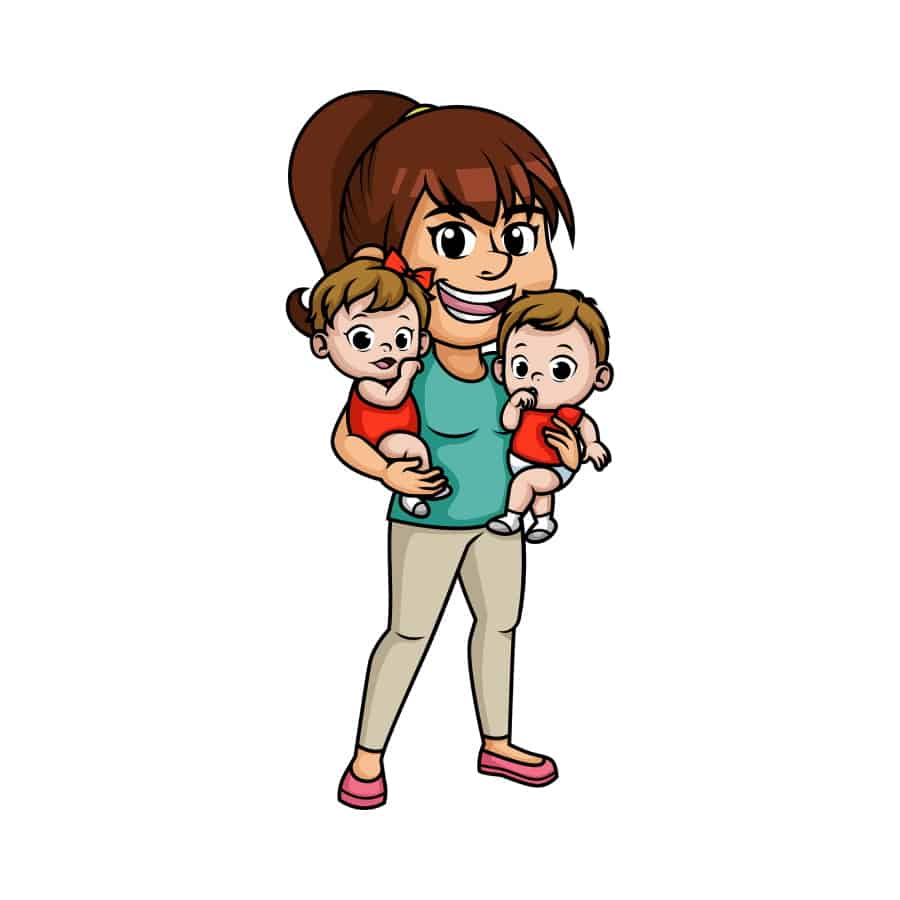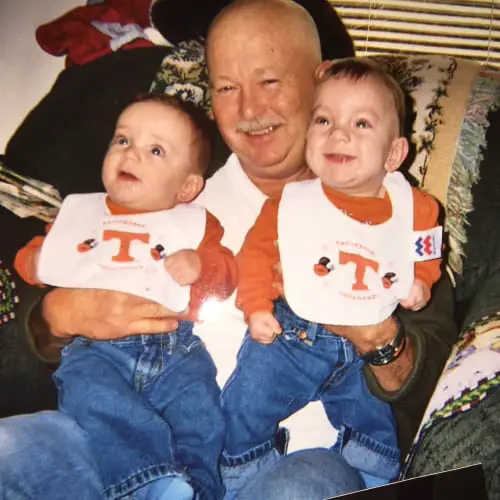
There are very few sounds that are as precious as that of a baby’s laughter, especially when it’s your baby! That laugh can melt away all the stress of your workday and bring you back down to Earth immediately. But what are the things that make babies laugh so infectiously?
Babies laugh for a variety of reasons. If you want be the cause of that infectious laughter, here are 7 things that make three month old babies laugh: belly raspberries, Eskimo kisses, funny faces, funny noises, peekaboo, pets, and other people’s laughter.
These, along with tons of other gestures, can bring your quiet home to life with the sounds of your baby’s laughter. In this article, we’ll talk about why babies laugh and discover what some of the research has to say that goes along with those reasons. If you want to learn the “how, what, and why” to making your baby laugh, you’ve come to the right place!
Contents
When Do Babies Start to Laugh?

Most babies begin laughing around three or four months old. This laughter is a great sign that they are developing in a typical fashion. However, not all babies are the same, and some will begin to laugh before or after this generalized timeframe.
Many parents and caregivers become concerned if a baby doesn’t hit this developmental milestone within the average timeframe. However, there is no need for concern unless there are multiple milestones the child hasn’t hit by the fourth month. It could be something as reasonable as it’s likely that your baby is a little more serious or less likely to giggle than others.
There is also the wish that a one month old’s smile or goo is a form of laughter. This may not actually be what we think it is. Many babies have involuntary smiles and even sounds that to adults signal good moods or even laughing.
Though your baby could be showing early signs of laughter, that smile could be because of itching, a hair tickling their cheek, or other stimuli that causes a reaction. Some babies react with squinching their eyes, while others may bring out a full blown toothless smile.
Whether it is early signs of a jovial infant or simply reactions to smells or a touch, it can still brighten the day of any parent or grandparent.
Why Do Babies Laugh for No Reason?
Babies sometimes seem to burst into laughter for no apparent reason. Have you ever noticed that a smile, some eye contact, or a funny noise can send an infant over the edge in laughter? This laughter is not really “for no reason.”
Many studies suggest that babies laugh as a means of communication. They want to feel as though they belong, and laughing is a simple way for them to let you know that they find something to be amusing. If you spend time and attention on them, they will likely find pleasure in it and therefore repay you with a smile and some giggles.
There are also a variety of stimuli that are likely to cause laughter in babies. These stimuli are typically the result of adult interaction and can sometimes be produced by interacting with other children. Either way, it is human connection that causes such laughter.
Children in general learn much of what they know through most of their stages by mimicking others around them. They have limited capacities for reasoning all the way up to the teen years. So trying to teach them through simple explanation is far inferior to an example.
This goes especially for babies whose communication skills are so limited and their brains are forming around the most basic of concepts and actions. Three month olds typically are reacting to the world around them. Sometimes though, you may find them trying some of what they have seen out on you.
This is a lot of fun. Make sure you don’t miss a minute of it. It is gone so fast.
Fun Ways to Make Your Baby Laugh

Now that we know a little bit more about why babies laugh let’s talk about how to get them to laugh. There are tons of things that traditionally make babies laugh. Most of them are far simpler than you might imagine. Here are just a few.
Belly Raspberries
This is a truly hilarious sensation for a child. It is the combination of the gentle touch and the funny sound that typically evokes laughter from a baby. Try doing raspberries with your baby and see how they respond.
Three year olds may even be shocked the first time or two. If they are do it a bit softer the next time. Once they are sure that it is fun and not scary, the louder the better. You would be surprised at how volume can play a big part in how funny something is to a baby.
Pets
Many babies have been known to react favorably to the feel of fur, wagging tails, and licking tongues. Be sure to watch the pulling and yanking on the fur that comes along with it, but pets can be a good source of laughter for three year olds.
Another way to have the family pet entertain your three year old is get them to making sounds. Some babies find a barking dog, meowing cat, or a talking parrot hilarious. They will switch between laughing and failing at mimicking the sounds.
While some parents find it terrifying to have an animal so close to their baby, others find it charming. Only you will know whether this is a good choice for your family.
Funny Faces
As babies begin to develop, they become more familiar with the faces of their parents, caregivers, and others who are in their lives regularly—as such, making funny faces at your baby is likely to invoke some giggles. They are used to seeing your normal smile, so a funny face is a change of pace for them.
This also can come in the form of overly exaggerated faces while doing normal things. It will focus their scattered attentions, causing them to notice the out of the ordinary expressions. Do it enough and they will recognize it as play and the giggles should begin.
Eskimo And Butterly Kisses
This is another sensation that has been known to cause laughter in babies. Whether it’s the closeness of your face to theirs or the feeling of your eyelashes, this will certainly create some giggles. The best part of giving Eskimo kisses to a baby is when they start to do the same in return!
For those that don’t know, there are two versions of this type of ‘kissing’ and are quite different. Neither one involves the lips in any way.
- Eskimo Kisses: These are done by rubbing the end of your nose on your baby’s nose in a light back and forth manner. It can be coupled with a silly face, but usually is a hit with just the familiar smile of mom or dad.
- Butterfly Kisses: To do butterfly kisses it takes a normal to long set of eyelashes. You bring your eyes as close to your baby’s cheeks as you can and begin to blink. Your eyelashes will tickle their cheeks and cause them to react.
Both types are a great way to play with your three month old and will not only cause them to let out some early signs of laughter, but it will also strengthen the bond between you and your son or daughter.
Peekaboo
Developmental psychologist Dr. Caspar Addyman has done tons of research on laughter in babies and found that peekaboo is by far the most popular game to play with your baby. It evokes tons of laughter and helps the child develop a deeper connection to the adults around them.
There are many versions of this game for babies. Sometimes it can be done with the hands and other times with much more effort using the entire body and a corner. They like the surprise and seeing your familiar face gives them the sense that they are understanding at least one thing in this strange new world.
Laughter in three year olds can turn into them participating when they become more able to use their hands. I have seen with our kids that they begin to put things over their faces or in front of ours to participate only a few months later.
Funny Noises
Children become accustomed to the world around them and begin to interpret sounds at a very early age. Unusual sounds such as popping your lips or kissing sounds are likely to evoke some laughter because they are not the normal sounds that the baby is used to hearing.
My husband used to get a chorus of laughter from our boys and even our daughter when they were little by making noises under his arm, with his hands, or from his mouth. Let’s just say these were ‘bathroom sounds’, but you know dads.
Laughter
As you might’ve guessed, we are talking about the laughter of other people. Like adults, babies often find that when other people are laughing, they can’t help to join in the fun. It’s almost inevitable when one person laughs, another will laugh, regardless of age or stages in life.
To really cause this to be effective, over do it a bit to let them know that it is really funny. They will want to mimic, communicate, and feel a part of the action. Sometimes all it takes is laughing yourself to get a baby to laugh. Now, go find your funny.
How Do These Stimuli Help Brain Growth?
It’s no secret that the first few years of a baby’s life are filled with tons of developmental stages. The environment in which a baby is raised can have a huge impact on that development. Studies have shown that providing a variety of stimuli on a regular basis helps build the brain at a much faster rate than fewer, less frequent stimuli.
In a nutshell, a baby’s brain is creating synapses during the early stages of life. It is developing its neural network, which will allow it to control the body and respond to various external and internal stimuli. Logically, the more stimuli provided during this critical time, the stronger the synapses will be.
Additionally, the stimuli need to be frequent and repetitive. This will help not only strengthen but also solidify the synapses in the brain. In other words, it will make the reaction to the stimuli and the impacted synapses permanent. Conversely, synapses that are not used will likely deteriorate and disconnect.
Laughter is a Social Connection
Laughter is definitely helpful in brain development for babies, but it’s so much more than that. As human beings, we have always searched for a human connection. It is part of our instincts and how we are wired internally.
In babies, laughter is a sign of social connection, trust, and various other things. They often giggle at eye contact, noise, gentle touches, and the like. They also laugh more frequently when they are with another person or in a room full of people, rather than when they are alone.
The social piece of laughter is the critical thing to understand as a parent, teacher, or caregiver to a child. Many children become upset at the touches or tickling of a stranger but burst into laughter when the same actions are experienced with a familiar adult. This is not a coincidence but rather a confirmation of the need for human connection at all stages of life.
Punchline for Things That Make Three Month Old Babies Laugh
Your baby’s laughter is not only music to your ears but also a telling sign that your baby is developing as expected. It signifies that your baby is happy, stimulated, and forming a bond with the person who is causing the laughter.
The early years of a baby’s life are critical to brain growth, and laughter is a huge part of building a strong, healthy brain, so laugh often with your baby!
Additional Resources: If you’d like more information, here are some great resources to learn more.
Infant Lab https://sites.gold.ac.uk/infantlab/
The Science of Baby Laughter https://www.researchgate.net/profile/Caspar-Addyman
Ted Talk https://www.ted.com/talks/caspar_addyman_why_babies_laugh/transcript?language=en
